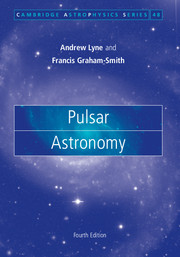Book contents
- Frontmatter
- Contents
- List of illustrations
- Preface
- 1 The discovery of pulsars
- 2 Neutron stars
- 3 Telescopes and techniques
- 4 The distances of the pulsars
- 5 Pulsar timing
- 6 Timing and astrometry of binary pulsars
- 7 Timing irregularities
- 8 The Galactic population of pulsars
- 9 The Crab and Vela Pulsars
- 10 Other young pulsars
- 11 Millisecond and binary pulsars
- 12 Accretion-powered X-ray pulsars
- 13 Magnetars
- 14 Supernovae and their remnants
- 15 Integrated pulse profiles
- 16 Individual pulses
- 17 Location of emitting regions
- 18 Radiation processes
- 19 The emission mechanisms
- 20 Interstellar scintillation and scattering
- 21 The interstellar magnetic field
- 22 Achievements and prospects
- References
- Index
13 Magnetars
Published online by Cambridge University Press: 05 March 2012
- Frontmatter
- Contents
- List of illustrations
- Preface
- 1 The discovery of pulsars
- 2 Neutron stars
- 3 Telescopes and techniques
- 4 The distances of the pulsars
- 5 Pulsar timing
- 6 Timing and astrometry of binary pulsars
- 7 Timing irregularities
- 8 The Galactic population of pulsars
- 9 The Crab and Vela Pulsars
- 10 Other young pulsars
- 11 Millisecond and binary pulsars
- 12 Accretion-powered X-ray pulsars
- 13 Magnetars
- 14 Supernovae and their remnants
- 15 Integrated pulse profiles
- 16 Individual pulses
- 17 Location of emitting regions
- 18 Radiation processes
- 19 The emission mechanisms
- 20 Interstellar scintillation and scattering
- 21 The interstellar magnetic field
- 22 Achievements and prospects
- References
- Index
Summary
The magnetars are a small group of neutron stars with extremely high effective dipole magnetic fields, comprising Anomalous X-ray Pulsars (AXPs) and Soft Gamma-ray Repeaters (SGRs). In both groups the rotation periods are long, and the slowdown rates are high, consistent with a high magnetic field and a short lifetime. The radiated energy is far higher than the rate of loss of rotational energy, and it is commonly assumed that the energy for the radiated X-rays and gamma-rays is derived from a decay of the magnetic field stored in the interior of the neutron star. The magnetars have been regarded as distinct from normal pulsars; it now appears that they may represent the extreme of a continuum.
The Soft Gamma-ray Repeaters (SGRs)
Cosmic gamma-ray bursts (GRBs) were first detected by satellites equipped with gamma-ray detectors, which were intended to monitor man-made nuclear explosions. The discovery was published in 1973 (Klebesadel, Strong & Olson 1973); since then some thousands of GRBs have been observed; many of these were measured from several satellites simultaneously, allowing positions to be determined from relative times of arrival. A typical GRB has a duration of some 10 s, and a rise time less than 1 s, but these are both widely variable; some bursts have structure within 1 ms.
- Type
- Chapter
- Information
- Pulsar Astronomy , pp. 184 - 191Publisher: Cambridge University PressPrint publication year: 2012

